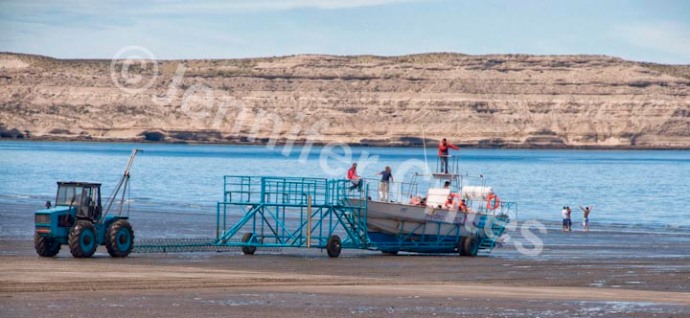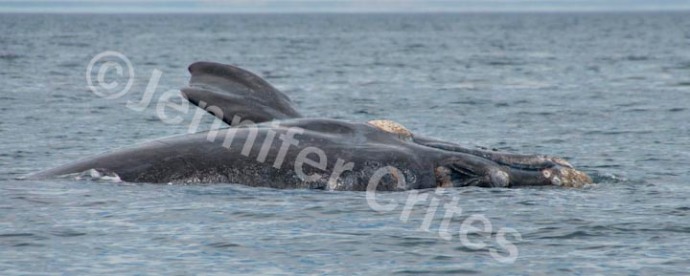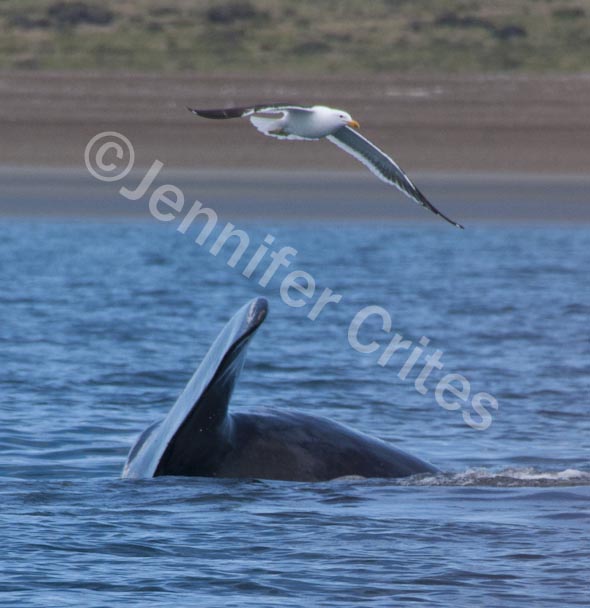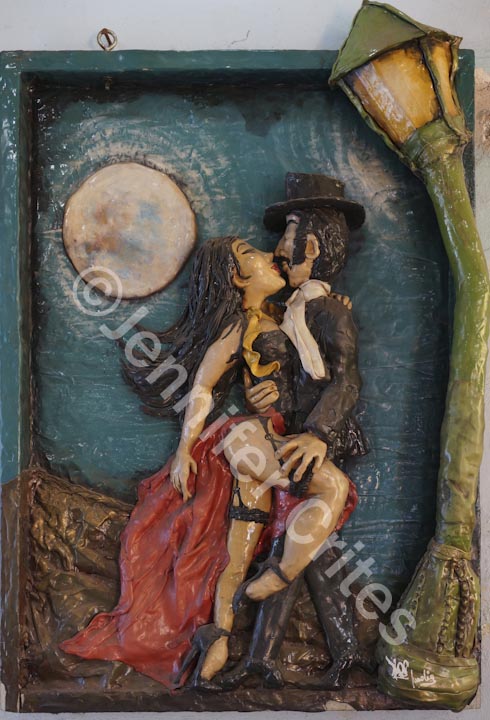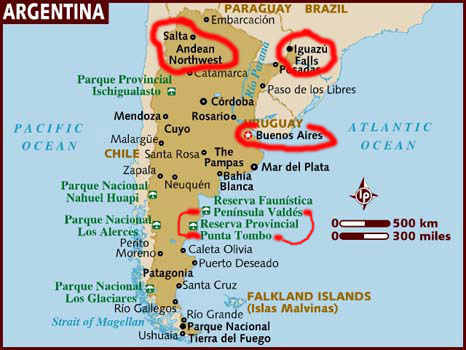 I’ll never forget the jolt of amazement when I rounded a bend on the elevated walkway and saw this view. To capture the breadth and the feeling of power emanating from such close proximity to the rushing water and billowing spray, I took four images, from side to side, and later stitched them together in Photoshop, creating this stunning panorama, which includes the Iguazu River and San Martin island.
I’ll never forget the jolt of amazement when I rounded a bend on the elevated walkway and saw this view. To capture the breadth and the feeling of power emanating from such close proximity to the rushing water and billowing spray, I took four images, from side to side, and later stitched them together in Photoshop, creating this stunning panorama, which includes the Iguazu River and San Martin island.
Posts Tagged With: Argentina
Photo of the Day: Iguazu Falls—a Natural Wonder
Spying on Southern Right Whales
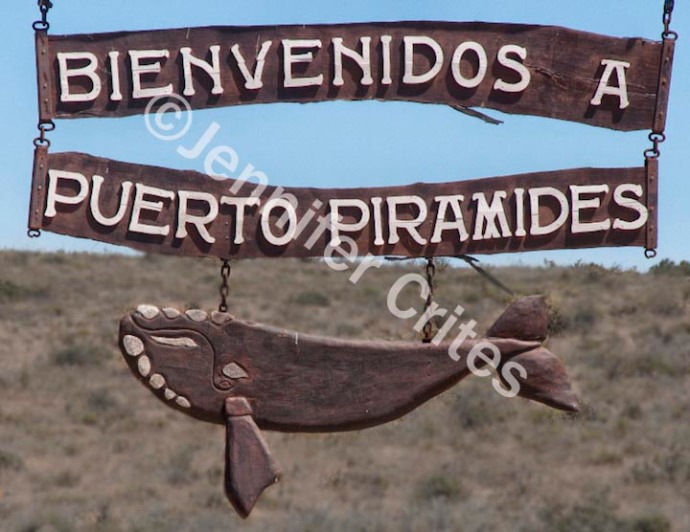 It’s early afternoon in Argentina’s Patagonia, and on Peninsula Valdes, the seaside town of Puerto Piramides is throbbing with tourists lining up to pay for their whale-watching tours. The little hamlet has grown up around these tours, with lodging, restaurants, souvenir shops and a tourist information bureau all catering to the trade and brimming with business.
It’s early afternoon in Argentina’s Patagonia, and on Peninsula Valdes, the seaside town of Puerto Piramides is throbbing with tourists lining up to pay for their whale-watching tours. The little hamlet has grown up around these tours, with lodging, restaurants, souvenir shops and a tourist information bureau all catering to the trade and brimming with business.
Beyond the last restaurant, on an ultra-wide beach fronting a horseshoe bay, there are no boat ramps. Instead, tractors—like monstrous crabs—chug across the sand, pushing and pulling tour boats into and out of the ocean with the aid of long metal arms. Ignoring the vehicles, groups of sunbathers and daytrippers dot the sandy expanse. There’s plenty of room for everyone.
From the ticket office, we march in line to the beach after donning our bulky orange life jackets. Across the sand we go, up the metal steps to the boat’s deck in search of a good seat. During a lengthy orientation in both Spanish and English (mostly Spanish), a tractor pushes us into the sea, and at the proper depth, we float off the trailer and are on our way to see the whales.
It’s speculated that right whales, both Northern (Pacific and Atlantic) and Southern, got their name because whalers declared them the “right” whales to kill. Preferring shallow coastal waters, they swim slowly, passing close to ports and lingering on the surface. All of which made them easy to harpoon. And once killed, they conveniently floated thanks to their thick blubber layer, which was rendered into oil.
Eventually, they became even more prized for their baleen—a tough yet flexible material that forms a giant sieve in each side of the whale’s mouth, allowing it to strain flea-sized copepods (tiny crustaceans) and krill from the water for food. An adult whale must eat a billion copepods a day to supply the minimum 400,000 calories it needs. Polite society, however, decided that baleen was more useful as corset stays, stiffeners in fashionable gowns, umbrella ribs and horsewhips (hence the phrase, “He whaled on me.”)
Even though no longer harpooned for their blubber and baleen, right whales are still fighting for their lives. All are endangered, but the eastern North Pacific population, numbering less than 50 animals, is critically endangered, while the eastern North Atlantic population may be considered functionally extinct, with only ten or so individuals left. Leading causes of death include collisions with ships and entanglement in fishing gear, but in Patagonia there is a lesser-known problem: seagulls.
Kelp gulls might be responsible for hundreds of southern right whale deaths—especially calves—near Peninsula Valdes. They land on the whales, pecking at them to tear off chunks of skin and blubber for food. The hours of harassment and extensive wounds cause stress and weaken the whales at a time when mothers are fasting and expending energy to feed their young. Since this is a recent discovery, no solutions have been found.
Right whales can weigh up to 90 tons, and an adult female can grow to 49 feet long. The male’s testicles weigh around 1,100 pounds each—the largest of any animal and easily surpassing the larger blue-whale’s 120-pound testes.
On this day, no males are available for corroboration, but before long, we spot a mother and calf. They venture close to our small boat, a mass of black skin and white tubercles or callosities that look like clinging barnacles. The callosities appear white thanks to large colonies of cyamids (whale lice).
The whales bob up and down on the water’s surface, checking us out, the mother positioning herself between the boat and her calf. Familiar with barnacle-clad humpbacks that spy hop, I strain to see the right-whale’s eye watching us, but it’s nowhere to be found. I learn that it’s halfway down the massive head, near the corner of the mouth—a curved, plunging line that separates a voluminous lower law from a long, thin upper jaw that reminds me of a safe-deposit box lid with a low hinge, or a trap door leading to a storage cellar.
Perhaps because of the odd mouth and lack of a dorsal fin, it seems like the whale is swimming upside down. I’ve heard that these animals can dive to 600 feet, sometimes flipping over and brushing their flat heads along the seafloor, waiting for the currents to sweep food into their cavernous mouths.
On occasion, I can see the mother’s blowhole. It looks oddly like the thick-lipped mouth on the Dairy Queen commercial, opening wide to suck in air or blow out a water spray, then closing tight before a dive.
Other curious mother-calf pairs check us out, too, but finally we head for shore, passing various sea birds and a colony of seals. The crab tractors are waiting for us when we arrive at the beach.
You can check out Jerry’s video here:
Futbol, Art and Tango in Buenos Aires
We were warned: Watch your wallets and purses if you go to La Boca, Buenos Aires’ rough-and-tumble barrio located at the mouth (boca, in Spanish) of the Riachuelo river along the city’s southern border.
During the day, however, the most clear and present danger to your cash lies with the hawkers and hustlers in La Boca’s Caminito—a colorful tourist trap lined with artists’ studios, trinket shops, cafés, musicians and tango dancers. If you like, you can have your photo taken with the dancers—for a price, of course.
As always, my focus was on photography. In particular, I wanted to capture the bright red, blue and yellow dwellings constructed mainly of planks, sheet metal and corrugated iron—cast-off ship building materials left over from the days when the neighborhood was lined with shipyards. Early dockworkers—settlers from Genoa, Italy—built the makeshift houses. Other Europeans followed. Today, many La Boca residents are of mixed European descent: Italian, Spanish, German, French, Arab and Basque.
Drab and dreary at their inception, Caminito’s houses were painted in 1960 by local artist Benito Quinquela Martin, who also erected a makeshift stage for performances. Now each café has its own narrow stage where singers, musicians and tango dancers perform for your pesos. The many hawkers can be annoying, but it’s a poor neighborhood and they’re just trying to make a living.
Not too far from Caminito, La Boca’s futbol (soccer) stadium rises from the narrow streets like a modern-day Roman Colosseum. Instead of gladiators and lions, however, the stadium—named La Bombonera (the candy box)—is home to Argentina’s most famous soccer team, the Boca Juniors, but rivalries with other teams—especially their sworn enemies, River Plate—are, it seems, just as fierce. When full of screaming, chanting, weeping, frenzied fans, the blue-and-yellow stadium, it’s said, shakes as if an earthquake is underfoot.
La Boca has a third claim to fame. In 1882, after a lengthy general strike, it seceded from Argentina—or tried to. Rebels raised the Genoese flag, which was immediately removed personally by then President Julio Argentino Roca.
Don’t Eat the Salt
The salt in Argentina’s Salinas Grande is not for eating. It’s mined for industrial sodium and potassium, which, in turn, is used for making soap, oven cleaners, drain openers and other products. But recently the mining emphasis in Argentina’s salt flats has shifted to another element that lies beneath the salt—lithium.
Not to get too technical, but the average concentration of lithium in mines worldwide is 1,100 ppm (parts per million). In Salinas Grandes, it’s up to 1,600 ppm.
And there’s a lot of it—about 20 million tons of the ore, from which can be extracted about 300,000 tons of pure lithium. Think about that the next time you buy a pack of lithium batteries (lithium is also used in ceramics and glass, electronics, lubricating greases, metallurgy, pyrotechnics, air purification, optics, and on and on).
But that’s not why I was there. I just wanted to see it—2,300 square miles of white stretching toward distant mountains. I had seen photos of people at these and other salt flats; they were doing fun things like jumping, lying down, and using the absence of scale to take photos—one appearing to stand in the hand of another. I wanted to do that, too, but by the time we got there, I had altitude sickness and could barely walk.
Because these salt flats are at an elevation of about 11,000 feet.
“You don’t have enough oxygen in your blood,” our guide told me as I wobbled out of the van complaining of nausea and dizziness. Before leaving the town of Salta that morning, he had stopped at a convenience store and instructed us to buy a bag of coca leaves (yes, THOSE coca leaves), a bunch of which we were to stick between our teeth and gums, swallowing the juices—a blood-oxygenating remedy for altitude sickness. I can’t say if I would have been worse off without the leaves, but I can tell you they are bitter, they poke the insides of your mouth, and I couldn’t wait to spit them out. (Coca tea, I found out later, is a much more pleasant alternative).
Actually, the salt flats weren’t exactly white because they were covered with layers of dust, which washes off with the summer rains. Good thing, too, because I lacked sunglasses and even the dingy saltscape was bright enough to make me squint.
You might be wondering how the salt comes to be there. We were actually standing on a lake covered with about twelve inches of hard-packed salt. Each year, rain in the mountains washes minerals down to this lake, renewing the crusted salt beds. To mine the minerals, workers simply chop out a 3×5-foot-by-six-inch-deep rectangle with a pick ax, then shovel the salt out and pile it next to the cut. Water seeps into the cut, and within six weeks, the sun evaporates the water, and salt fills in the cut as if it had never been made.
The road we had traveled runs through this white sea on its way to Bolivia, and I noticed that a number of black vehicle tires had been placed here and there on the flats adjacent to the road. They’re markers, I was told—a warning to anyone planning to drive onto the expanse of whiteness for a photo op. Like thin ice on a frozen pond. Unwary vehicles have broken through the crust and become stranded. Tractors, bulldozers and backhoes—like salt Zambonis—do venture onto the flats to move and collect the salt, but they know which spots to avoid. At least, I assume they do.
Next to the tourist-van parking lot, I peered in the window of a building and found rows of salt tables—workstations for packing the salt into blocks, perhaps? Outside, some of the 20-somethings in our group gleefully climbed on the mounds of salt, defying a sign that specifically said, in Spanish, do not climb on the salt.
We heard that sometimes you could find a craft market next to the roofless outdoor café—its tables and benches made exclusively from salt bricks. But on the day we visited, the café was deserted, and we found no market—just a shelf containing a few miniature llamas carved from salt.
Argentina’s Gauchos
Some say there are no real gauchos in the traditional sense—rebels who never settled down, who defied authority, ignored the law, and were so attached to their horses that when they finally dismounted, they walked with permanent bowed legs. “A man on foot is half a gaucho,” the saying goes, “because the gaucho and his horse are one.” But in Argentina, many proudly consider themselves gauchos and carry on gaucho traditions.
Each year, in early November, the Argentine pampa town of San Antonio de Areco holds a Dia de la Tradicion (day of tradition), which is actually a week-long festival of all things gaucho. We had planned to be there for the festival’s ending—a parade of gauchos—hundreds of them—through town, followed by displays of gaucho horsemanship. To our dismay, the festivities were cancelled at the last minute in response to reports of a gathering storm.
Nobody was happy with that decision, including the gauchos, especially when we arrived at San Antonio de Areco and the weather was picture perfect. So instead of the parade (and the crush of thousands of people that we were doing well to avoid, our tour guide assured us) we would tour the sleepy town itself, with visits to a famous gaucho bar, and shops crafting leather goods, handmade ponchos and silver knives.
Gauchos differ from American cowboys in many respects, including their rejection of guns. Instead, gauchos carry knives—long and sharp, with elaborately carved handles—which they stow at the back of their leather belts and employ for everything: cutting firewood, fixing saddles and lariats, making adobe bricks, skinning cattle, carving off chunks of meat at mealtime, and in the early days, occasionally as a weapon.
After our tour (and the spotting of a few gauchos who flaunted the festival cancellation and rode their horses around the town square anyway), we headed to a nearby estancia (ranch) where the first order of business (after a short trail ride on the ranch’s horses) was lunch. In the cookhouse, a hearty meal was being prepared: meat, meat and more meat—steaks, chicken and sausages—as well as other delectable salad/vegetable dishes and Argentine Malbec wine.
Once satiated, we gathered on the lawn outside the stone portico where lunch had been served to watch a demonstration of the bonding between a gaucho and his horse. Trained with respect and affection, our guide explained, the horse trusts his gaucho completely, and vice versa. The photos tell the story.
At a nearby field, another gaucho demonstrated a technique in which unbridled horses have been trained to shadow a “follow horse” led by the gaucho. It was like watching a school of fish moving as one, twisting and turning whichever way the gaucho led them.
Too soon it was time to start the 90-minute drive back to Buenos Aires.
Note: Yes, we missed the gaucho parade, but that’s not the end of the story. Stay tuned to successive posts, and you’ll find out why.
Argentina: The Journey Begins
Argentina is a country of contrasts. And it’s BIG. Boarding five internal flights in three weeks, we sampled four different locales: city life in Buenos Aires and a visit to a pampas estancia (ranch) where gauchos rule the range; the big-sky country of Patagonia at Trelew and the Peninsula Valdes area with its southern right whales, elephant seals, dinosaur skeletons, penguin colony at Punta Tombo, and even a Welsh village with tea shops; Iguazu Falls’ rainforest majesty; and Salta’s multi-colored mountains, cactus forests, salt flats, and high desert where I stood next to a llama and hoped it wouldn’t spit on me. It was all quite amazing, and I’ll be posting more about our adventures in this incredible country
But for now, let’s start with a pictorial gallery. Click on any image below the maps to start the slideshow.

